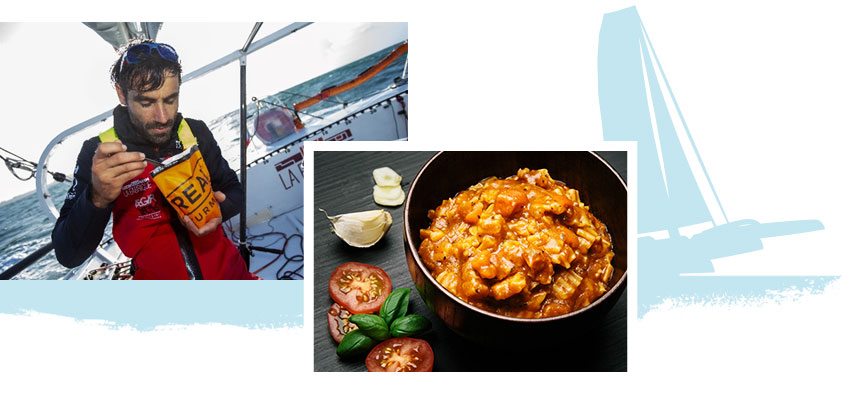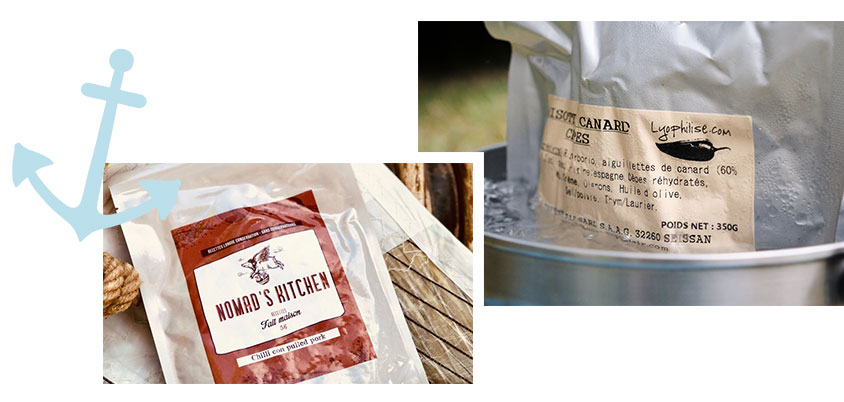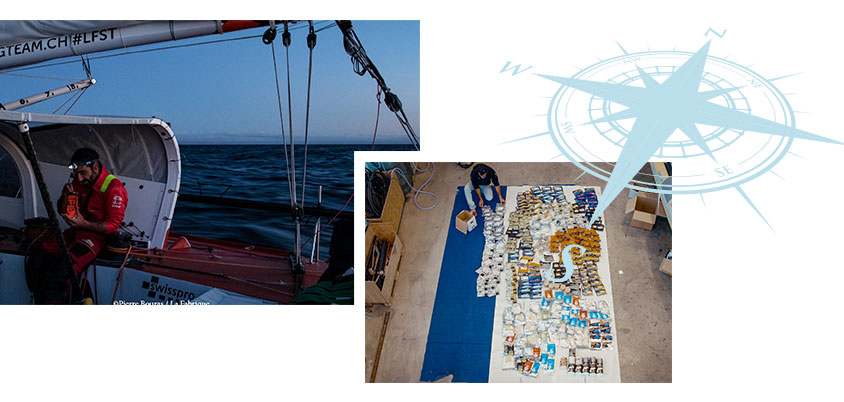Sailling - What type of food ?
Uptated October 2021
Therefore, what food products should you bring to eat well while you're on board ? Many sailors may have in mind « powdered » tasteless Bolino-type meals with low nutrition value and ingredients of uncertain origin ! Stereotypes about freeze-dried meals die hard, yet for the past few years, freeze-dried products have improved significantly with a strong tendency to offer natural recipes (with no additives and no preservatives), including organic recipes (we'll get there bit by bit). Through this article, we'd like to share our story on the catering adventure including freeze-dried recipes and other food options along with food complements. 1,2,3, let go !
Freeze-dried food, forget your preconceptions !
Convenient, light weight meals with a long shelf life
Given their low weight, compact size and long-term shelf life (between 5 and 7 years for meal pouches and up to 25 years for food tins), freeze-dried meals are easy to stack and store making them the perfect solution for boats equipped with a watermaker.
Preparing your freeze-dried meal is child's play but there are some steps to be finessed there. The crucial stage is the quantity of water you have to add. This criteria is to take into account since you might otherwise end up with a soup if too much water was added, or conversely, you might end up with a powder paste. But don't worry, if the latter occurs, simply add more hot water, wait a few more minutes and your recipe will be « perfect » to eat. Most of the meal pouches feature a water line but anticipation can save your lunch. In any cooking gear, a measuring device (bottle, cup…) could be a meal saver !

After you have successfully completed the water stage and your meal is well mixed, then comes the waiting stage. 8-10 minutes are usually enough for rehydrating your meal, but this time is purely indicative and is dependent upon the type of recipe, the way it is prepared… If you rehydrate your meal using cold water, you'll have to be even more patient… favor potato-based recipes, vegetables or even pasta, and put aside rice-based recipes. However, breakfasts and desserts (muesli, chocolate mousse…) are ideally suited for cold rehydration, which helps you save fuel.
Usually packed in individual pouches, some recipes come also in « large size » or « double portion » pouches, better yet in « multi-portion tins », and you can eat directly from the pouch. There is practically no longer the tedious chore of cleaning the dishes !
Taste and appearance
Used not only by ocean racers but also by hikers, mountaineers and even astronauts, freeze-dried meals show an interesting nutritional content compared to other preservation methods.
Inspired by European, Asian, Indian cuisine and flavors from all over the world, the taste and appearance of a freeze-dried meal, after rehydration, are close to those of a fresh product. Most of the recipes contain nice pieces of meat and veggies, but let's be honest, it all depends on the brand. In fact, some brands concentrate on fully cooked authentic dishes before further processing while other brands combine single different ingredients to make their recipe. The quality and the origin of the latter ones must be taken into account when selecting your meals, and no doubt these criteria affect the cost.
Freeze-drying process steps
Regardless of the « manufacturing method » used by our suppliers mostly based in Europe, the freeze-drying process for a food or a meal includes a series of steps. In order, the process involves freezing, vacuum, and then sublimation, that is, the moment when the so-called “free” ice evaporates without melting.
If water molecules are still bound to the product, they are removed when the product is placed under a deep vacuum and a progressive heat input is added until getting back to positive values. The scientific name for this step is « desorption », it allows foods to be kept at room temperature.
The process can take as long as one week ! By removing 94% to 97% of the water in the food, freeze-drying reduces chemical reactions to a very low level.
An outstanding preservation of nutritional value in foods
Organoleptic (taste) characteristics are very well preserved, along with nutritional and biological attributes (especially protein-based foods showing a very low variation). Finally, vitamins C and Beta carotene (among the most sensitive) withstand the whole process quite well : estimated loss is no more than 10%.
For many sailors, freeze-dried recipes contribute to their daily calorie intake on board. For example, for ocean races such as the Volvo Ocean Race, for some passages through cold areas, female and male sailors can eat up to 6,000 and 7,000 kcal a day ! In comparison, a sedentary male needs three times less this amount.
So, to optimize their energy intake and supplement their freeze-dried meals, many sailors bring energy and protein bars aboard, along with dried meats or sports drinks to keep their energy up.
A disadvantage ?
The freeze-drying method is a drying process that requires a lot of energy and so it is rather expensive. Easy to prepare, freeze-dried meals require you add potable water before eating them. This can limit their use if access to potable water is unavailable ; sterilized meals then provide a suitable food option.
Sterilized or appertized meals, what's that ?
This is a range that Freezedried & Co has developed at the sailors' request. The purpose was to vary flavor and meal ideas and to complement our freeze-dried range.
Sterilized foods have many advantages with very few cons : we'll explain what we mean !

An ancient preservation method
Using the traditional method of packing food in glass bottles, the meals are cooked then sterilized at high temperature for a certain amount of time, thus extending the shelf life between 1 and up to 6 years. Packed in pouches, they cannot break, contrary to glass jars.
If we describe the process further, appertization destroys micro-organisms that could develop within the product under normal conditions of storage. The process consists of preparing the food, precooking/cooking it, then packing it in a sealed pouch. Often times, the product is packed first then sterilized in an autoclave at 100°C (different from pasteurization, where a heat treatment of 85°C is applied).
This technology is affordable for traditional caterers ; some made-in-France « catering » recipes have been added to our range of sterilized meals at Freezedried & Co. Most of sterilized recipes do not contain any additives or preservatives.
What about nutrition ?
This method of food preservation causes a 30% to 50% loss of vitamins (especially B and C), even more for some ingredients, but it extends the shelf life of food up to 6 years in some cases depending on food packaging. As far as food taste and texture go, they are usually well maintained.
You can heat your meals using any cooking gear at hand !
As far as preparation goes, even if you can eat some recipes « cold », they taste much better « hot » by using a water bath, your frying pan or microwave oven. It should be noted that another « heating » option is on the rise among sailors : self-heating systems have become very popular in the past few years.
Most sterilized brands are using these « flameless stoves ». The operating method is simple : water (potable or not) activates the integrated flameless heater to heat the meal. You need to place your meal in the heater, wait a few minutes, and then you can eat a warm meal without using any gas stove or wood fire.
Is there any disadvantage in consuming sterilized meals ? … Well, it may turn out to be an advantage !
The weight, heavier than freeze-dried meals, because water is not removed during the sterilization process. However, that constraint can be turned into an advantage ! Actually, since you don't need to add any potable water to your food, you can be 100% self-sufficient on your boat even if it is not equipped with a water maker. So then, many minimalist people enjoy this type of meals, along with some sailing's biggest stars and amateur yachtsmen.
A combination of both methods ? Yes, it's possible !
Depending on everyone's tastes and equipment, combining both food methods when sailing is feasible. Ready-to-order food kits including snacks, or not, are available on our website Freezedried & Co, but you can also make your own meal combination using our online store (or from our local store at Lorient for the lucky ones who are close by !).

What's important is to favor meals of quality, and to supplement them with energy bars, beverages, and chocolate for those who want so, and why not with cans of pate made by a famous manufacturer from Brittany ! Because food is not only about ensuring your body to function properly but it's also about boosting your morale so you can enjoy your sailing adventure even more.
All that said, enjoy your meal !
Photos : Cristophe Breschi, Alan Roura, La Fabrique, Julien Rabier, Nomad's Kitchen
